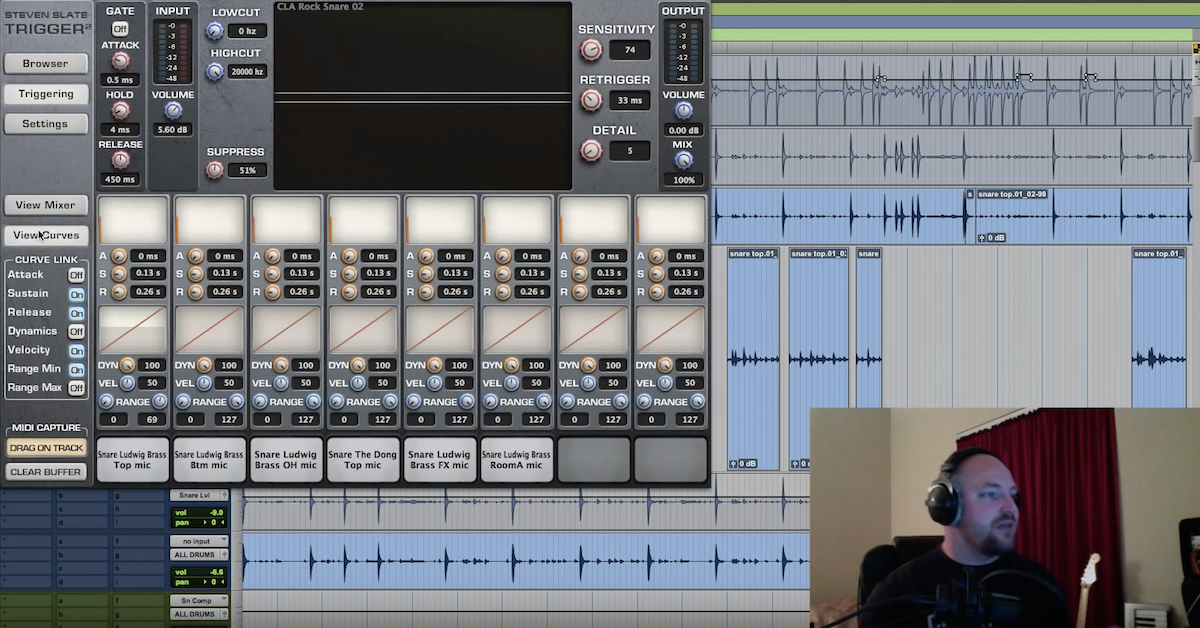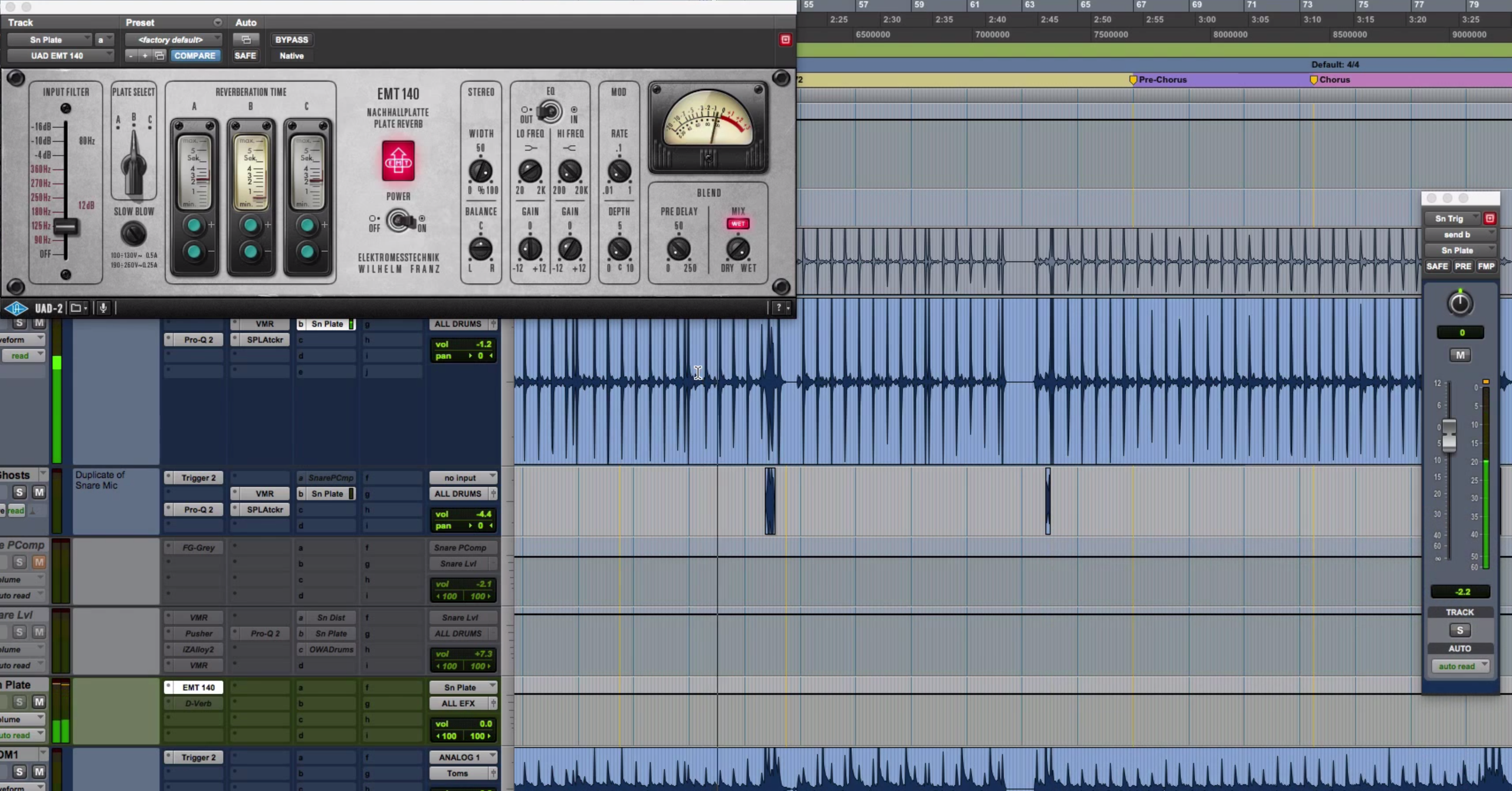4 Ways to Get a Phat Snare Sound
Now, I’ve picked four great snare drums here to do this demonstration with. They’re all DW. I have two in the cherry gum Jazz Series line, this red one right here, and my signature yellow Tony Williams yellow lacquer snare drum over here.
I have a Design Series Maple drum over here, and over here on my far right is a Performance Series Maple drum. Now, all of these drums are five and a half by 14. Now, five and a half inches deep is not really the typical size you might think of for a deep, phat snare drum sound, but with these techniques, I think you’ll be able to get that phat snare drum sound you’re looking for.
The examples I’m going to show you today are either free or very inexpensive to do, and the first one I want to show you is the tuning example. First thing I want to show you is the bottom head. Now, I do this with all of my snare drums, whether it’s going to be a high pitched cracky sound, or this deep pitched thuddy sound.
So let me take this stick, stick it under the wire so you don’t hear the buzz. Now really, this snare drum bottom head is already tuned, I just want to show you how tight it is. I crank up the bottom head on all of my snare drums. I think it just gives you a really good feel, and it allows the snare wires to do their thing and snap on and off the head when the stick hits the top — the batter head.
So see if you can hear this pitch.
[hitting resonant head]
It’s pretty high pitch, and it’s cranked up not so tight that you’re going to break the lug or stick the tuning rod too far in, it’s just good and snug all the way around, and again, to get you that high pitched kind of sound.
And again, I do that on all of my snare drums. It really makes the top head, when the stick hits the head, feel really good.
Let me turn the snare back over and show you the rest of it.
Alright, this main snare drum here, I’ve turned back over, and I’ve cranked it back up to sort of a normal pitch, really high, nice feel, great rebound.
[drums]
Definitely cutting, very loud. Now, I’m going to show you how to tune this down. I will freely admit to you on this video today that I found this technique while searching the internet just like everybody does on different snare drum sounds, different techniques on tuning, and this one just works every time. It’s really, super easy to do.
Alright, the snare drum is tuned up really high, all of the lugs are pretty even all the way around. The main thing about this technique is that you’re going to detune the three lugs that are closest to your body. The center lug pretty much all the way off, and the two on either side of that center lug down about maybe three quarters, and you kind of have to just mess with it until you get it in the right spot, but once you learn how to do it, it’s really simple.
So here we go. I’m going to start with the center lug, and just crank it all the way down. Now it’s completely loose. Now, when I start detuning the lugs on either side of that one, this one will actually get back some tension.
About three turns on each side. Now you’ll notice that center one has tension, so detune it even more.
Alright, let’s hear what the snare drum sounds like.
[snare]
Definitely going down in pitch, and it’s getting very dry sounding. A lot of the ring and overtones are gone. A little bit more going down on the two side lugs. Now that’s almost like I have a bunch of Moon Gel or tape on the top of the head, there’s nothing there at all. That’s just that head with these three lugs detuned, and you get a phat snare drum sound.
[snare]
I would suggest, while you’re at this point, to check the tension of the other lugs around the drum, because as you detune these ones on the bottom, you will change the ones on the top, and you want to keep the rest of them tight.
So that feels good. Those all feel pretty tight and snug.
Now let’s go back down here real quick.
[snare]
That’s pretty phat sounding.
[drums]
And again, it’s great for the studio, when you want to play Funk, Pop, R&B, or some old school Rock and Roll, a snare tuned down to this pitch will really work well for you.
I quickly want to mention the snare heads I have on all of these drums, they’re all single-ply, coated heads. Evans G1 here on the center drum, the drum on my left has a Remo coated Ambassador, and the two drums on my right have Aquarian texture coated single-ply heads. All great heads, and all kind of do the same sort of thing.
Now, the tuning option of this phat snare drum how-to video takes the longest. The rest of these options are very quick. The next technique I want to show you involves this. The Big Fat Snare Drum. This is a killer accessory you can buy here at Sweetwater, and it works without having to change the tuning of your drum at all. If you want that kind of fat old Don Henley sound, this is a great and very easy way to get it.
So here’s the drum without it on.
[drums]
Very high pitched, great overtones, great feel in the hands. But now, I don’t have that much time, I’m in a session, lots of pressure, we’ve got to get the song done now, they want that fat snare drum sound. Well, you’ve got your Big Fat Snare Drum. Chuck it on top of your head, and check this out.
[drums]
It’s a killer sound. It takes away all of the overtones, it gives you that thuddy feel without having to change the tuning, and it just again, it works every time.
The next technique I want to show you involves this guy. The Remo Ring. A very simple product. When you buy the package here at Sweetwater, it comes with a number of rings in it. Usually ten inches up to about 16. So you can use them on your toms, or any of your other drums.
Let’s hear this snare drum without the ring on it.
[snare, no Remo Ring]
Nice sounding maple drum, good overtones, feels good in the hand, but you want that dry thuddy sound. Grab your Remo ring, stick it right on, here you go.
[drums, with Remo Ring]
That sounds good, it’s pretty dead, it’s pretty thuddy. Now tune it down a little bit, and you can get even more thud. I’d say about a half turn, quarter turn on all of the lugs, and you’ll be there.
[snare]
It’s getting big, it’s getting round, and fat sounding.
[drums]
Alright, now let’s get into the last drum over here. Another free technique to give you that fat snare drum sound, and it involves your trusty wallet. Now, I would probably say I don’t keep that much stuff in my wallet, but you could go down that sort of Seinfeld, George Costanza route where you keep every receipt known to man in your wallet and get even more of the thuddy sound, but this one, just kind of hang the top over. If you do need some Gaff tape, or duct tape to hold it down, you might have to do that, but this one is staying pretty good for me right now.
First, let me play you the snare drum without the wallet on it.
[snare, no wallet]
Again, a great sounding DW snare drum, nice and big sounding, warm, lots of overtones, feels really good in the hands. Now, take your trusty wallet, stick it over the side, this should stay pretty good, there you go. Let’s see how this sounds.
[snare with wallet dampening]
You can also tune this drum down a little bit, about a quarter turn on each lug, and get it thuddy and sounding just like the white drum right here.
So now, let me play all four drums, four different techniques, and four fat sounding snare drums.
[drums]
And there you have it, everybody. Four techniques to a fat snare drum sound. Check them out at your next studio session or your next live gig, and hopefully they’ll give you the sound you’ve been looking for.
If you want any information about any of the drums I’m playing here on today’s video, the heads, the sticks, the recording interface, or the microphones, check out the text at the bottom of the video, there’s links to all of the gear, or contact your Sweetwater sales engineer. Thanks a lot for watching.





